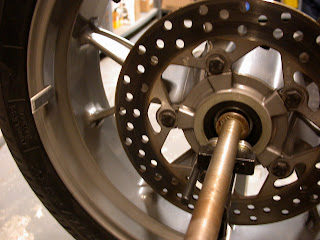 Here's the naked wheel on the balancer to find the true heaviest spot.
Here's the naked wheel on the balancer to find the true heaviest spot. The two red dots on the tire represents the lightest point- mount the tire with these at the "true" heaviest point on the rim (or the valve stem if you didn't check the rim first).
The two red dots on the tire represents the lightest point- mount the tire with these at the "true" heaviest point on the rim (or the valve stem if you didn't check the rim first).
The first thing to do is set the wheel (from now on "wheel" will refer to the rim/tire) on the balancer, making sure the rod or axle is level, and give it a good spin. Position yourself so that your can "eyeball" the top of the tire as it spins and use a reference point in the distance to check for any up and down movement, also check for any side "runout". If the wheel has a wobble it could be a slightly bent rim or tire that is not seated properly on the rim. If everything is true, continue on.
Slow the spinning tire until it settles to a stop. Note: As you become better at the process you'll get a feel for how much weight to start with to get close. The heaviest spot is now at the bottom (6 o'clock). Add a strip of weights (as shown below) opposite this spot (12 o'clock), then move it to the 3 o'clock or 9 o'clock (below) position and let it go. If it begins to drop to the bottom, cut a little bit of the strip off, you'll get the hang of how much to remove by the speed that it drops. Keep playing with the length of the strip until it stays there or moves very little. I like to position the wheel at different spots and check for movement. When your sure that the weight added compensates for the heavy point on the wheel, give it a few small spins and make sure that it stops at random spots. If it stops and then changes direction or speeds up it's still off a little and you'll have to make adjustments.
Once you're positive that you have a nice balanced wheel, carefully remove the weight strip, clean the rim and apply it to the rim. If it's a wide rear wheel try to get it directly in the middle of the rim or if it's a narrow rim and you have a lot of weight, divide the strip in half and put an equal amount on both sides.
Before removing the wheel from the balancer double check your work.
There it is.....a pretty straight forward technique for checking your wheels for trueness and getting a perfect balance, just like the professionals.


















